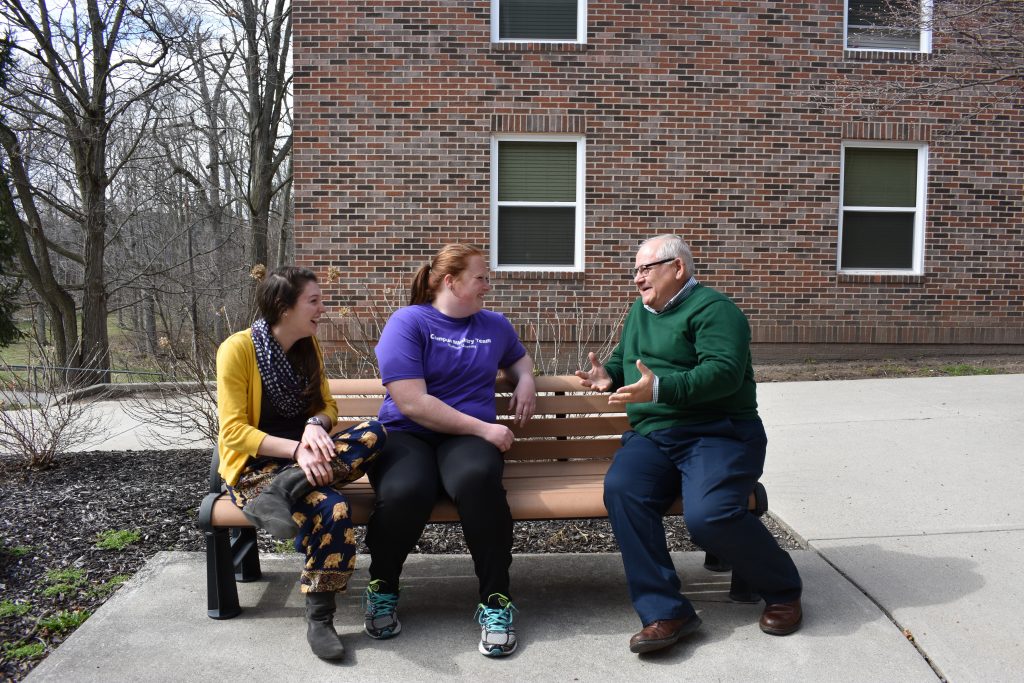
Bluffton University Campus Pastor Tig Intagliata meets with Katey Ebaugh (left) and Maelinn DeLong. Photo by Emily Huxman
By Emily Huxman
In late February an article published at faithit.com titled “59 percent of Millennials Raised in a Church Have Dropped Out—And They’re Trying to Tell Us Why” started trending on Facebook.
Interestingly enough, Bluffton University has had a falling Mennonite student population over the years, with it currently as low as 9.9 percent according to the Registrar’s Office, and that’s just Mennonites. There are other denominations represented on Bluffton’s campus that might be affected by this trend as well.
With this new trend of millennials turning away from the church, religious institutions like Bluffton may have reason for concern. Campus Pastor Stephen (Tig) Intagliata says there are many reasons he believes young people are turning away from the church.
For one, he says, young people like to have a voice in the things they are involved in.
“For many young adults, it can be difficult to find a church community they can be involved in and where they feel they have some control over what happens there,” says Intagliata.
Wanda Stopher, lead pastor at First Mennonite Church in Bluffton, had similar thoughts on this trend.
“College students want space to make their faith their own,” she said.
Stopher has been a pastor at First Mennonite Church since October 2016 but hasn’t been worried about the attendance among college students at her church.
“Young adults are their own people and like to do their own thing. We can do better as a church to engage them, but I think first they need the space to decide for themselves what they want to do with their spirituality,” says Stopher.
Since 2010, Millennials’ rating of churches and other religious organizations has dipped 18 percent points, from 73 percent to just 55 percent, according to PEW Research.
Intagliata has been monitoring the attendance of chapel on campus, which has decreased over the decade.
“The number of students that are involved in any kind of spiritual life on campus has probably gone down in the last ten years,” says Intagliata. “Chapel attendance specifically has gone down quite a bit, I mean it’s probably less than half it was when I first came to Bluffton.”
Intagliata attributes the population decline of millennials in church to several factors.
“The culture is changing. Less and less people are growing up in the church. The church used to be the center of society, and today it’s just not like that anymore,” says Intagliata.

Katie Roushia photo by Emily Huxman
Many students on campus can identify with this trend. Senior Katie Roushia says, “I’m not necessarily any less religious than I was when I lived at home, I just don’t go to church as often now that I’m at school.”
She says many young adults, herself included, find it hard to find engagement in the church and she wishes it was easier for young adults’ voices to be heard.
Many religious institutions like Bluffton University can’t help but wonder if this newly recognized trend might hurt their enrollment numbers. But Stopher has a different perspective on this.
“I think this area in particular has more hope. This area has a lot of churches, and what seems to be a very active religious community,” says Stopher.
At her church, many older members at First Mennonite have a similar fear. The increasingly small population of young people at church concerns them but Wanda Stopher isn’t worried.
“I’m not troubled,” Stopher said. “The way I see it is, it’s a sign that something’s happening. I don’t feel that I need to try and fix it. I do believe God works through the chaos of societal changes.”






